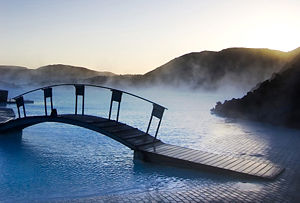Iceland's Blue Lagoon, skin aging and psoriasis
 The practice of balneotherapy, also known as water treatment or spa therapy, has experienced a resurgence in popularity in recent years, especially amongst those with skin diseases such as psoriasis and atopic dermatitis. Salts, minerals, and bacteria particular to certain geothermal springs in various locations throughout the world have long been touted as having beneficial effects on skin, including significant reductions in lesions associated with psoriasis.
The practice of balneotherapy, also known as water treatment or spa therapy, has experienced a resurgence in popularity in recent years, especially amongst those with skin diseases such as psoriasis and atopic dermatitis. Salts, minerals, and bacteria particular to certain geothermal springs in various locations throughout the world have long been touted as having beneficial effects on skin, including significant reductions in lesions associated with psoriasis.
Of particular interest is the Blue Lagoon on the peninsula of Reykjanes in Iceland. A heating plant was built on the penninsula in 1976 to take advantage of naturally occurring geothermal activity. The Blue Lagoon was formed when hot water was discharged into an adjacent lava field. The lagoon water has an average temperature of 37°C, a pH of around 7.5, and a salt content of 2.5%. One of the plant workers with psoriasis began bathing in this new lagoon and his condition was greatly improved; this led to an instant and quickly growing interest in the healing potential of the Lagoon amongst sufferers of many types of skin diseases.
The Lagoon’s unique chemical and bacterial composition is found nowhere else in the world. The chemical composition of the Lagoon is (in mg/kg of Lagoon fluid): SiO2 137, Na 9280, K 1560, Ca 1450, Mg 1.41, CO2 16.5, SO4 38.6, H2S 0.0, Cl 18500, and F 0.14. The Lagoon waters also contain coccoid and filamentous blue-green algae not found under similar conditions anywhere else.
Early studies of the Blue Lagoon’s effect on both diseased and healthy skin has proven that bathing in the lagoon, and particularly applying the Lagoon’s white silica mud to the body, results in a significant reduction — oftentimes complete elimination — of even the most severe symptoms of psoriasis. Recent research published by Grether-Beck, et al. shows that these beneficial effects are not limited to diseased skin, and in fact the lagoon waters and mud have an anti-aging effect on healthy, normal skin.
While these initial studies demonstrated a beneficial effect of the Blue Lagoon on the skin, it remains to be discovered exactly what properties of the fluid and mud confer this benefit. In their recent paper, Grether-Beck, et al. prepared silica mud and microalgae extracts from Blue Lagoon mud and water samples to study their effects on in vitro epidermal keratinocytes and dermal fibroblasts (i.e., skin cells) as well as in vivo effects after topical treatment in healthy volunteers.
Since skin conditions like psoriasis and atopic dermatitis are characterized by reduced skin barrier function, and keratinocyte differentiation is a key component in determining the quality of the skin barrier, it is interesting to note that silica mud extracts stimulated expression of keratinocyte differentiation markers, as did both algae types, albeit to a lesser extent.
Extracts from silica mud and Blue Lagoon coccoid and filamentous algae also significantly inhibited ultraviolet (UV) radiation-induced metalloproteinase-1 (MMP-1) expression, which was associated with a concomitant inhibition of UV-induced interleuken-1 (IL-1) and IL-6 expression. Additionally, Blue Lagoon coccoid and filamentous algae extracts significantly upregulated expression of Collagen 1A1 (COL1A1) and COL1A2 in dermal fibroblasts — two genes which are critically involved in collagen synthesis.
Upregulation of keratinocyte differentiation markers was associated with a significant reduction in transepidermal water loss of treated skin areas in vivo; COL1A1 and COL1A2 expression also increased in treated skin after 4 weeks of treatment.
While such research is exciting, further investigation of the effects of the combination of Lagoon chemicals and bioactive molecules is necessary for a complete understanding of the therapeutic potential of the Blue Lagoon. Additionally, some data about the longevity of its beneficial effects on skin is warranted as well.
Medical tourism to the Blue Lagoon is growing. In 1994 Blue Lagoon opened an outpatient psoriasis clinic (renovated in 2005) with two dermatologists and three nurses on staff. Treatment consists of twice-daily dips in the Lagoon, during which silica mud is applied to psoriatic lesions, and UVB treatment in a phototherapy cabinet. Blue Lagoon skin care products can be purchased in Iceland, Nordic capitals, and online.